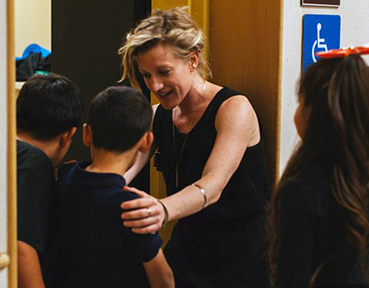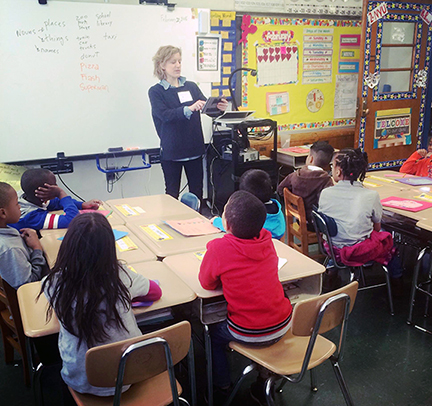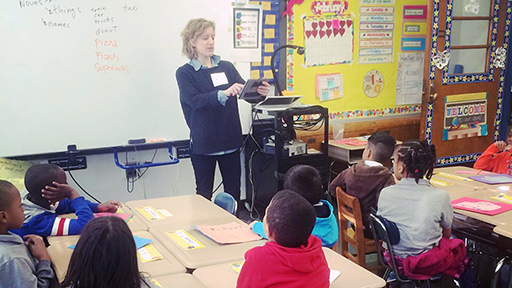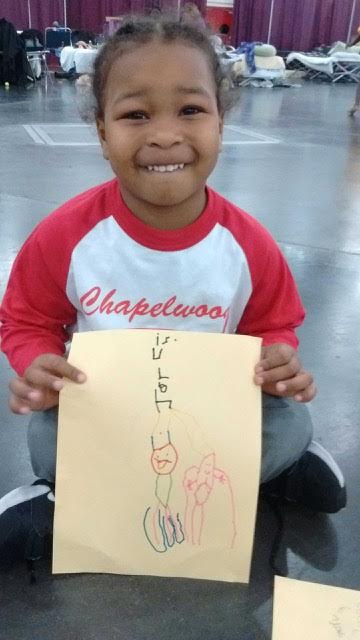Sarah Guayante, a student at St. John’s University and a T&W editorial intern, is interviewing teaching artists who take part in the TATIP* program. Erin Anderson, an actress teaching with Community-Word Project, attended the seminar about teaching in after-school programs, which was facilitated by Brooke Rogers of Wingspan Arts and Patricia Chilsen of Community-Word Project.
Teachers & Writers: How do your roles as teacher and actress overlap? Does your experience as a teacher influence your work as an actress?
Erin Anderson: I’ve been teaching and working with kids for a long time in a more academic setting. I have so much joy being able to work with people toward a common goal in the theater, where you have to have courage as an individual to speak, but you have to find a way to also collaborate and support an ensemble. In the classroom, I talk about what it takes to move towards something together while individually finding a way to open up. When I’m working with young people, I find that they’ve never been asked to do both those things at the same time. I find as an adult that’s also challenging. So, it’s been educational for me as I’ve reflected back on: How do I communicate these ideas to young students? And, how do I make sure I’m actually fulfilling them in my own professional work?

T&W: When you are in the classroom, what are the most important things about performing you want to communicate to your students?
EA: When kids are getting up to fourth and fifth grade, they’re starting to really try and figure out who they are as individuals, establish their identity. A lot of kids are starting to perform in their daily lives—in social situations, or to teachers or at home. So we talk about wearing masks in my classes. What are the masks we put on to get through our day, and how can we apply the idea of mask work, wearing an emotional mask, in peer games we play to understand it a little more? Since these kids are always feeling like they have to play a certain part, either to each other or to grown-ups, I try to emphasize that in performance, you have an opportunity to try on all kinds of different personas. You don’t have to be the certain person that everyone expects you to be all day long. This is an opportunity to break through that, open up, discover something else, and not have to fulfill some pre-established role.
T&W: In your experience, what does including arts education in the curriculum give to students?

EA: I think it gives them another way into understanding concepts. It combines an intellectual approach with body learning. What’s really important about it is empathy, finding ways to empathize with other people’s experience so that, as a performer, you can step into that and embody it for others to see. You have a different experience when you’re considering another person’s life and you’re approaching it from a place of empathy. You can talk to kids all day long about what a person’s situation has been or something historical that’s happened, but bringing that below the neck and figuring out ways to tell those stories in a dual mode is really important.
T&W: How do you design your lesson plans? What sparks them? Do you use any online resources, books, or magazines?
EA: I have a real mélange of things I’ve thrown together over the years. With any good acting, you’re borrowing a little bit of something you’ve seen before and making it your own. So I learned from elders, I learned from fellow teaching artists; but I also learned from the group of my training. I had a background in a troupe of a theater company I was involved in for many years and they did commedia dell’arte, the Italian and French style of Renaissance theater. I use that all the time as a way of teaching about character work, the specificity of how you build an image of a character and what we can learn about someone just by looking at them. Once students learn that you can get so many great comic improv situations out of throwing these stock characters together, they can come up with anything, and that’s a great way to convey what someone wants, an intention, what someone needs and why, and what end they go to to make it happen.
T&W: How will what you learned in the TATIP after-school seminar inform your teaching?
EA: What really hit home in the after-school discussion is the importance of separating that time period from what’s come before and what’s come after, setting an opening ritual and a closing ritual that act as a framework in which the experience that they’re about to have with me can live. I want them to know that once we do that opening ritual, we’re going to theater land. That closing ritual is how we wrap it all up together as this unit where we’ve done something collaboratively. It’s the challenge of how to create structure around what you’re doing while still making it fun and connecting it to the work you’re about to do.
T&W: What rituals have you tried to separate those students into that after-school period?
EA: I was teaching quite young ones—pre-K—at a school last semester, and the class was Fairy Tale Theater. We had to move from the auditorium, up two flights of stairs, and down a corridor to actually get to the place where we were having class. It was total madness. I said, “Okay, everybody! Before we start, we have to take our invisible magic potion. Everyone pull it out of your pocket.” They just look at me like, “Wait, what? I have one in my pocket?” I said, “Look, it’s right here in your pocket! We have to drink our potion so we can go through the corridor where the dragon lives to get to our special story cave.”
The next time we had class, I totally forgot about it and they said, “Wait, Ms. Erin, we have to take our potion or we can’t get there.” And, I said, “You’re exactly right!” It inspired them; it really lit up their imaginations and they didn’t forget it. It became a way to connect the idea of magic and the subject and the material that we were going to be playing with.
*The “TATIP Cohort” is part of Community-Word Project’s eight-month Teaching Artist Training and Internship Program (TATIP). This select group of New York City arts education organizations is a partnership initiative to expand professional development not only for the TATIP students, but also for teaching artists working with these organizations. Our mission is to combine efforts to better prepare artists to bring arts to city classrooms. With professional development seminars that deconstruct the dynamics of teaching artistry in a variety of settings and focus areas, the January-May Saturday sessions are geared towards developing new ways of stimulating creativity and understanding in students.
The TATIP Cohort partners with Community-Word Project, include:
Brooklyn Arts Council
Center for Arts Education
Dreamyard Project
FreeArts NYC
MagicBox Productions
Marquis Studios
Maxine Greene Center
National Dance Institute
New Victory Theatre
Teachers & Writers Collaborative
Wingspan Arts
Voices Unbroken



